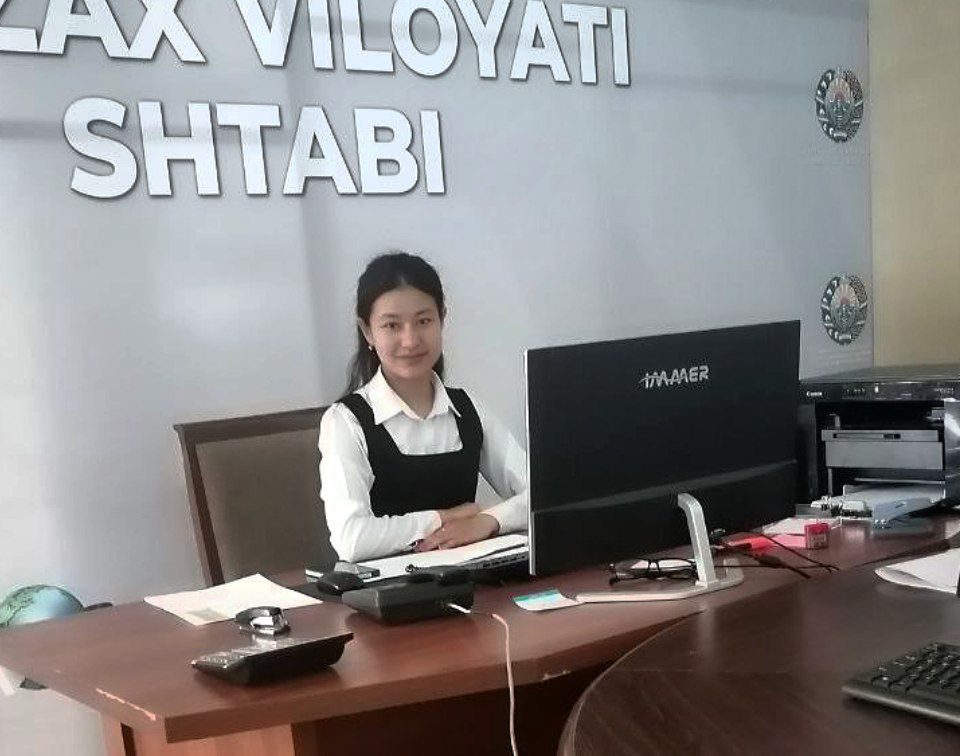Bekmurodov Abdujabbor Sattorovich
Associate Professor, Doctor of Philosophy in Biology (Phd),
Department of Zoology, Termez Staty University, Termez, Uzbekistan
Mamarajabova Matluba Tilakovna
Lecturer, Department of Zoology, Termez Staty University, Termez, Uzbekistan
Saidova Elmira Anvarovna
Lecturer, Department of Zoology, Termez Staty University, Termez, Uzbekistan
ABSTRACT:
The article provides data on the distribution of phytonematodes
by representatives of the order Tylenchida (Filipjev, 1934) Thorne, 1949 in the apple orchards of the Surkhandarya region of
Uzbekistan. As a result of the study, 28 species of phytonematodes were identified in the root system and root soil of apple plants. During the research, species dominated Filenchus filiformis, Psilenchus hilarulus, Ditylenchus intermedius, D.myceliophagus,
D.triformis,Tylenchorhynchus cylindricus, Bitylenchus dubius, Quinisulcius capitatus, Merlnius brevidens, Rotylenchus robustus,
Helicotylenchus dihystera, H.erythrinae, Pratylenchus pratensis,
Paratylenchus hamatus and Ditylenchus dipsaci.
KEYWORDS:
Phytonematodes,
apple orchards, order Tylenchida, root system, rhizosphere, phytohelminths of nonspecific pathogenic effect,
phytohelminths of specific pathogenic effect.
INTRODUCTION:
Phytoparasitic nematodes among parasites and pests of wild and cultivated plants are not the last in nature. The Tylenchida order occupies a special place in the phytohelminthology system, since it contains the central and most important group of phytonematodes,
represented by typical phytohelminths: pathogenic forms that cause plant diseases -phytohelminthiasis.
When studying some crops and their nematological fauna, it turns out that yield losses are determined not only by the harmful activity of the “stylet nematodes” of the tylenchid order. The forms of this group of nematodes are also involved in the processes of saprobiotic decay and expand, the volume of the affected areas of plant tissue as a result of vigorous inoculating function [9, 446 p.].
On the territory of Uzbekistan, in particular the Surkhandarya region phytonematodes of apple orchards were studied by E.T.Turaev, T.S.
Skarbilovich [1, pp. 58-61.], Sh.Kh. Khurramov,
E.T. Turaev [2, p. 115-124.].
MATERIALS:
To study the distribution in apple orchards of the Surkhandarya region of Uzbekistan in the period from 2020 to 2021. We collected phytonematodes from the root soil and root system of plants in shirkat farms from the territory of the Surkhandarya region of the Republic of Uzbekistan. The studies were carried out by the generally accepted route method [9, 446 p.]. During the phytohelminthological study, 700 samples of soil and root system of apple plants were collected and analyzed.
METHODS:
Phytonematodes were removed by the Berman funnel method and fixed with a 4% formalin solution. Enlightenment of nematodes was carried out in a mixture of glycerin with alcohol (1: 3), and permanent preparations on glycerin were prepared for in-office processing of the material according to the Seinhorst method [10, P. 67-69.]. Soil samples for the presence of cysts forming nematodes were usually analyzed according to the standard Decker method [3, 445 p.].
The species composition of nematodes was studied under an MBR-3 microscope. To determine the species, we used morphometric
indicators obtained according to the generally accepted De Man formula [4,104 p.] In its modification according to Micoletzky [6, 650p.]. The degree of dominance of phytonematodes in plant and soil samples was determined from the percentage state of individuals of certain species to the number of all detected by Witkowsky [5, – 53 p].
RESULTS:
For the entire period of phytohelminthological studies of apple orchards on the territory of the Surkhandarya region of Uzbekistan, representatives of the order Tylenchida, we
identified 28 species of phytonematodes.Discovered species belonging to 3 suborders (Tylenchina, Criconematina, Hexatylina), 5 superfamilies (Tylenchoidea, Dolichodoroidea, Hoplolaimoidea,
Criconematoidea, Anguinoidea), 7 families (Tylenchidae, Dolicilenidae, Dolichodoridae, Tylenchorhynchinae, Psilenchinae, Rotylenchinae, Rotylenchoidinae, Pratylenchinae, Paratylenchinae, Anguininae, Nothotylenchinae) and 14 genera
(Tylenchus, Filenchus, Aglenchus, Tylenchorhynchus, Bitylenchus, Quinisulcius, Merlnius,Psilenchus, Rotylenchus, Helicotylenchus, Pratylenchus, Paratylenchus, Ditylenchus, Nothotylenchus).
PHYTOHELMINTHS OF NONSPECIFIC PATHOGENIC EFFECT:
In our material, they are represented by 11 species:
Tylenchus davainei Bastian, 1865 was identified in the roots and rhizosphere of apple plants in the Saryassi, Muzrabad, Jarkurgan and Angora regions of the Surkhandarya region.
Filenchus filiformis (Butschli, 1873) Meyl, 1961 was registered in the roots and rhizosphere of apple plants in Baysun, Denau, Sumkurgan, Saryassi, Termez, Muzrabad and Angora
districts of Surkhandarya region. F.infirmus (Andrassy, 1952) Andrassy, 1976 was found in the rhizosphere of apple plants in the Angora and Termez districts of the Surkhandarya region.
F.leptosoma (De Man, 1880) Andrassy, 1972 was found in the roots and rhizosphere of apple plants in the Dzharkurgan, Bandykhan and Angora districts of the Surkhandarya region.Aglenchus agricola (De Man, 1884) Meyl, 1961 was found in the rhizosphere of apple plants in the Jarkurgan, Termez and Muzrabad districts of the Surkhandarya region.
Psilenchus hilarulus De Man, 1921 found in the roots and rhizosphere of apple plants in Denau, Baysun, Kumkurgan, Muzrabad and Angora districts of Surkhandarya region.D.intermedius (De Man, 1880) Filipjev, 1936 was found in the roots and rhizosphere of apple plants in the Uzun, Altynsai and Angora districts of the Surkhandarya region.D.myceliophagus Goodey, 1958 was found in the roots and rhizosphere of apple plants in the Altynsai, Saryassi, Dzharkurgan, Muzrabad,
Terme and Angora districts of the Surkhandarya region.D.triformis Hirshmann et Sasser, 1955 was registered in the roots and rhizosphere of apple plants in the Jarkurgan, Bandykhan and Muzrabad districts of the Surkhandarya region.Nothotylenchus acris Thorne, 1941 was found in the roots and rhizosphere of apple plants in the Jarkurgan, Termez, Saryassi and Muzrabad districts of the Surkhandarya region.N. exiguus Andrassy, 1958 was found in the rhizosphere of apple plants in the Angora, Dzharkurgan and Termez districts of the Surkhandarya region.
PHYTOHELMINTHS WITH A SPECIFIC PATHOGENIC EFFECT:
In our research, they are represented by 17 species:
Tylenchorhynchus cylindricus Cobb, 1913 was recorded in the roots and rhizosphere of apple plants in the Angora, Denau, Dzharkurgan and Termez districts of the Surkhandarya region.T.brassicae Siddiqi, 1961 was found in the roots and rhizosphere of apple plants in Baysun, Denau, Kumkurgan, Saryassi, Dzharkurgan, Muzrabad and Angora districts of Surkhandarya region Bitylenchus dubius (Butschli, 1873) Siddiqi, 1986 was registered in the roots and rhizosphere of apple plants in the Baysun, Denau, Kumkurgan, Saryassi, Dzharkurgan, Muzrabad and Angora regions of the Surkhandarya region.
Quinisulcius capitatus (Allen, 1955) Siddiqi, 1971 was found in the roots and rhizosphere of apple plants in the Termez, Jarkurgan, Muzrabad and Angora districts of the Surkhandarya region.Merlnius brevidens (Allen, 1955) Siddiqi, 1975 was recorded in the roots and rhizosphere of apple plants in Baysun, Denau, Kumkurgan, Saryassi, Dzharkurgan, Muzrabad and Angora districts of Surkhandarya region. Rotylenchus robustus (De Man, 1876) Filipjev, 1934 was found in the roots and rhizosphere of apple plants in the Termez, Denau, Kumkurgan, Saryassi, Dzharkurgan and Angora regions of the Surkhandarya region.
Helicotylenchus dihystera (Cobb, 1893) Sher, 1961 was found in the roots and rhizosphere of apple plants in the Termez, Saryassi, Dzharkurgan and Angora districts of the Surkhandarya region.H.digonicus Perry, 1959 was recorded in the roots and rhizosphere of apple plants in the Termez, Saryassi, Dzharkurgan and Angora regions of the Surkhandarya region.H.erythrinae (Zimmermann, 1904) Golden, 1956 found in the roots and rhizosphere of apple plants in the Shurchinsky, Baysunsky, Altynsai, Kumkurgan, Saryassi, Uzun, Bandykhan, Sherabad, Termez, Muzrabad and Angora regions of the Surkhandarya region.
H.multicinctus (Cobb, 1893) Golden, 1956 was found in the roots and rhizosphere of apple plants in Sherabad, Termez and Angora districts of Surkhandarya region.
H.pseudorobustus (Steiner, 1914) Golden, 1956 was found in the roots and rhizosphere of apple plants in the Dzharkurgan, Termez and Angora districts of the Surkhandarya region.Pratylenchus pratensis (De Man, 1880) Filipjev, 1936 found in the roots and rhizosphere of apple plants in the Baysun, Denau, Altynsai,
Kumkurgan, Saryassi, Bandykhan, Dzharkurgan, Termez, Muzrabad and Angora regions of the Surkhandarya region.P.crenatus Loof, 1960 was found in the roots and rhizosphere of apple plants in the Altynsai, Kumkurgan, Saryassi, Dzharkurgan, Termez, Muzrabad and Angora regions of the Surkhandarya region. P.penetrans (Cobb, 1917) Filipjev et Sch.
Stekchoven, 1941 was found in the roots and rhizosphere of apple plants in the Kumkurgan, Dzharkurgan, Termez, Muzrabad and Angora districts of the Surkhandarya region.
Paratylenchus bukowinensis Micoletzky, 1922 was identified in the roots and rhizosphere of apple plants in the Kumkurgan, Saryassi,
Dzharkurgan, Termez and Angora regions of the Surkhandarya region.
P.hamatus Thorne et Allen, 1950 was found in the roots and rhizosphere of apple plants in Denau, Jarkurgan, Termez, Muzrabad and Angora districts of Surkhandarya region.
Ditylenchus dipsaci (Kuhn, 1857) Filipjev, 1936 was recorded in the roots and rhizosphere of apple plants in Denau, Altynsai, Saryassi, Uzun, Termez and Angora districts of Surkhandarya region.
DISCUSSIONS:
During the studies carried out from phytohelminths of a nonspecific pathogenic effect, the species Filenchus filiformis, Psilenchus hilarulus, Ditylenchus intermedius, D.myceliophagus, D.triformis were identified in numerous specimens in the roots and rhizosphere of apple plants. Among phytohelminths with a specific pathogenic effect, the dominant species were Tylenchorhynchus cylindricus, Bitlenchus dubius, Quinisulcius capitatus, Merlnius brevidens, Rotylenchus robustus, Helicotylenchus dihystera,
H.erythrinae, Pratylenchus pratensis, Paratylenchus hamatus and Ditylenchus dipsaci.
CONCLUSION:
For the entire period of phytohelminthological studies of apple orchards on the territory of the Surkhandarya region of Uzbekistan, representatives of the order Tylenchida, we identified 28 species of phytonematodes (phytohelminths of nonspecific pathogenic effect-11 species, phytohelminths of specific
pathogenic effect-17 species).
The results of the phytohelminthological study showed that phytonematodes of the order Tylenchida cause serious diseases in apple orchards in the Surkhandarya region of Uzbekistan and cause great economic damage to the productivity of these crops. Therefore, the study of the distribution and species composition, bioecological features and substantiation of measures to combat these pests is of great scientific and practical importance in the fruit growing of the Republic of Uzbekistan.
REFERENSES:
1) Тураев Э.Т., Скарбилович Т.О. Динамика
фауны нематод яблони в
Сурхандарьинской области Узбекистана.
Бюл. ВИГИС, 1981.1/31. С. 58-61.
2) Хуррамов Ш.Х., Тураев Э.Т. К вопросу
изучения нематод плодово-ягодных
культур юга Узбекистана. Узбекский
биологический журнал. 1978. С.115-124.
3) Dekker H. Nematodes of plants and the fight
against them. – M. Kolos, 1972. 445 p.
4) De Man J.G. Die einheimischen, frei in der
reinen erde und im siissen wasser Lebenden
Nematoden. – Tijdschr // Nedrl. Dierk.
Vereen, 1880. – V.5. – 104 p.
5) Witkowski T. Struktura zgrupowania nicieni
zyjacych w glebie upraw rolniczych // Stud.
Soc. Sci. Torum. 1966. T.8. – No.3. – 53 p.
6) Micoletzky G. Die freilebenden ErdNematoden, mit besonderer
Berucksichtigung der Steiermark under
Bukowina, zugleich mit einer Revision
samtlicher nicht mariner, freilebender
Nematoden in Farm von esenus–
Beschreibungen und Bestimmungsschlusselh // Arch. Naturgesch. -1922. Ant.
A. – Vol. 87. – 650 p.
7) Kiryanova E. S., Krall E. L. Parasitic
nematodes of plants and measures to control
them. – Moscow: Nauka, 1969. – Vol. 1. 447




